Service Alert
July 1 - Canada Day
CELA will be closed on Tuesday, July 1st for Canada Day. Our office will reopen and our Contact Centre services will resume on Wednesday, July 2nd. Enjoy your holiday!
CELA will be closed on Tuesday, July 1st for Canada Day. Our office will reopen and our Contact Centre services will resume on Wednesday, July 2nd. Enjoy your holiday!
Showing 1 - 20 of 8344 items
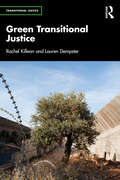
By Rachel Killean, Lauren Dempster. 2025
This book rethinks the boundaries of transitional justice, urging scholars and practitioners to confront the often-overlooked nexus between mass violence…
and ecological harm.Through an in-depth analysis of the field’s limitations – such as its anthropocentric legalism, neocolonial practices, and alignment with neoliberalism – the book critiques the historical marginalisation of Nature in transitional justice discourse and practice. It argues that ignoring environmental harm not only undermines the possibility of holistic justice but also perpetuates structural violence and inequality. In response, the book sketches a ‘greener’ transitional justice, integrating principles from environmental justice, Indigenous knowledge systems, and ecocentric perspectives. It explores the possibilities of recognising Nature as a victim of mass violence, adapting existing mechanisms to incorporate environmental harm, and fostering transformative approaches premised on the interdependence of human and ecological well-being.This book is written for students, researchers, and practitioners of transitional justice and fields related to conflict transformation, peacebuilding, environmental protection, and development.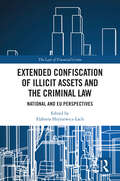
By Elżbieta Hryniewicz-Lach. 2025
The European Union is developing instruments which allow law enforcement and judicial authorities to freeze, seize and confiscate illicit assets…
in a simplified way. Oversimplification of confiscation procedures may, however, result in violation of fundamental rights and general principles of law aimed at ensuring protection of individuals against interference from the State. Such risk exists in particular in the case of extended confiscation, where assets forfeited go beyond what is proven as resulting from a concrete criminal offence. This book drawing on the results of a large international project, brings together a group of experts to determine the requirements needed to achieve compliance of extended confiscation with the fundamental rights and legal principles included in the Charter of Fundamental Rights of the EU, European Convention of Human Rights and in national legal orders of the EU Member States. Divided into three parts, the first details the national perspectives of 14 countries. The second part presents analysis of extended confiscation in comparative terms. The third and final parts examine extended confiscation in the context of the EU criminal law. The book thus provides a detailed analysis of extended confiscation from a number of perspectives and will be an invaluable resource for academics, researchers and policymakers working in the areas of Financial Crime, Comparative Criminal Justice and Human Rights Law.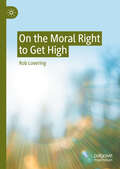
By Rob Lovering. 2025
Is getting high immoral? In this book, Rob Lovering defends the claim that it is not. More specifically, he argues…
that recreational drug use (of which getting high is a token) is neither intrinsically, nor generally extrinsically, immoral. In other words, he contends that recreational drug use is neither immoral in and of itself nor generally immoral due to an immoral-making factor with which it may be contingently linked [e.g., harm]. Lovering does so by offering two arguments for recreational drug use&’s ultima facie (all things considered) moral permissibility and critiquing twenty-four arguments for its immorality.Meant to be a companion to Lovering's A Moral Defense of Recreational Drug Use (Palgrave Macmillan, 2015), which was written for a general audience, this book is written for an academic—specifically, philosophical—audience and explores recreational drug use in a deeper, more philosophically and empirically rigorous way.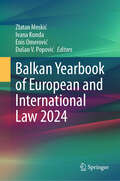
By Ivana Kunda, Dušan V. Popović, Enis Omerović, Zlatan Meskić. 2025
The special section of the BYEIL 2024 is devoted to the topic: Sustainability and Law. The special topic aims to…
contribute to the research field with emerging trends by providing a deeper and more compact understanding of the interplay between law and sustainable goals. The UN adopted the 2030 Agenda that embodied sustainable consumption and production patterns as one of the 17 Sustainable Development Goals (SDG). SDG 16 is directly related to law and includes peace, inclusive societies, access to justice and effective and accountable institutions. The authors made contributions to the various fields related to various SGDs providing insights into the ways in which these goals may inform policymaking, regulatory frameworks and judicial practice.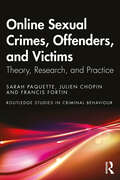
By Julien Chopin, Sarah Paquette, Francis Fortin. 2025
Adopting a multidisciplinary perspective, this volume explores contemporary knowledge regarding the online sexual exploitation of children and adolescents, and challenges…
prevailing myths perpetuated by society and the media concerning this form of violence, the offenders, and their victims.Drawing on a wealth of data collected from real cases in Quebec, the book introduces readers to explanatory models of online offending and victimization, the criminal trajectories and characteristics of online offenses, the individual attributes of offenders and victims, issues pertaining to virtual identities and anonymity preservation techniques, and considerations for prevention and intervention practices.Online Sexual Crimes, Offenders, and Victims will be of interest to students, researchers, and professionals in the fields of criminal justice and public health, including criminologists, psychologists, psychiatrists, psychotherapists, social workers, police investigators, probation officers, magistrates, and lawyers.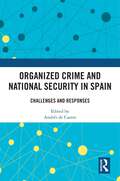
By Andrés De Castro. 2025
This book offers an analysis of how organized crime operates in Spain and the security apparatus designed to contain it.Organized…
crime is currently one of the most serious security threats facing democratic societies. Despite its intense presence and the responses that states have articulated in recent decades, little attention has been paid to the measurement of the effectiveness of the means adopted to combat it. Thus, this volume delves into this issue and performs an analysis of the police dimension of the response to organized crime in Spain. Firstly, this volume describes the international phenomenon of organized crime and its evolution in Spain, and continues by analyzing the profile and the characteristics of the different police forces and their resources and capabilities. This book then discusses the consequences of the measures at international level, European Union level, and local level, in relation to other police forces. Finally, the volume addresses the legal and public policy efforts that Spanish Law Enforcement Agencies have made in supervising or regulating their own police forces, which is necessary to carry out a detailed analysis of the consequences on the presence and strength of organized crime in the structures, strategies and decisions that Spain adopted over the last decades. As a result, this book builds on and updates the previous work by international scholars and proposes an interesting methodology that can contribute to the advancement of security studies.This book will be of interest to students of organized crime, criminology, Spanish politics and security studies.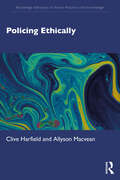
By Allyson Macvean, Clive Harfield. 2025
At a time when much in UK policing is the subject of intense public and media scrutiny, there prevails a…
practitioner discourse about policing ethically that is ongoing formally in police ethics committee discussions, and probably informally in station offices, canteens, classrooms, and police vehicles. Since January 2024, these conversations have added emphasis with the publication of the College of Policing’s revised Code of Ethics with which policing practitioners in England and Wales are coming to grips. This book explores thinking about policing ethically for those who have to use and implement the ideas – to those who, when law and policy is silent on the matter before them, nevertheless have to make a justifiable decision and act upon it.Applicable to policing generally, not just to the UK, Part 1 of this book presents conceptual contextualization for thinking about policing ethically. Following which, Part 2 considers practical implications of policing ethically.Some of the key topics that the book covers are as follows:• Discussions of managing power and vulnerability• Implementing frontline ethics in practice• The process of making ethically informed decisions• Considerations around ethics and the use of artificial intelligence by policing practitioners• Prerequisites to ethical leadership• Considering “public interest” in relation to policing ethically• Risk management as a moral obligationDrawing upon the policing practitioner and policymaking experience of the authors, this book will be of interest and use to all those involved in delivering policing: constables of all ranks (student, probationary, and experienced), policing community support officers, professional support staff, policing ethics committee members, and policymakers. The book is also a contribution to the wider academic literature on policing and ethics, and will be of interest not only to policing ethicists and ethnographers but also to students and policymakers in the fields of criminology, sociology, and governance.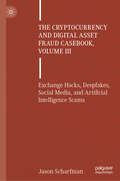
Cryptocurrencies and digital assets have continued to gain widespread acceptance from both retail and institutional investors. Alongside this rapid growth,…
the digital ecosystem remains plagued by bad actors who prey on the space. These range from state-sponsored North Korean hacker groups, Russian ransomware gangs, multinational organized criminal enterprises to lower-level Chinese gangsters and run of the mill romance scammers. These criminals indiscriminately target victims across all demographics. Furthermore, cryptocurrency-related scams continue to present increasingly significant threats to institutions and national security. Since the publication of The Cryptocurrency and Digital Asset Fraud Casebook volumes I and II, scammers have only intensified the sophistication and scope of their attacks. This evolving threat landscape, coupled with a rapidly changing regulatory environment, underscores the ongoing need for up-to-date information and analysis. The Cryptocurrency and Digital Asset Fraud Casebook, Volume III: Exchange Hacks, Deepfakes, Social Media, and Artificial Intelligence Scams is essential reading for anyone seeking the latest insights into fraudulent activity within the cryptocurrency and digital asset space.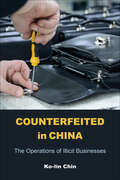
By Ko-Lin Chin. 2025
Counterfeiting tops the list of organized crimes committed worldwide, raking in nearly half a trillion dollars in 2019. The impact…
of this illicit business is felt by consumers, brand owners, state authorities, and workers, and it impacts the economy. Moreover, its proliferation has fueled the advancement of organized crime groups. In his illuminating study, Counterfeited in China, Ko-lin Chin investigates this lucrative industry and its emergence in China. His face-to-face interviews with counterfeiters — business owners, workers, facilitators, and key informants — in the hub of Guangzhou, China reveal how businesses that design, produce, and distribute fake and unauthorized luxury goods manage the risks inherent in their business. Counterfeited in China examines the individual and group characteristics of counterfeiters and their relationships with organized crime; analyzes the economic aspects of counterfeiting; assesses the relationships among counterfeiting, violence, and corruption; and seeks to understand the demand for counterfeit goods. Chin also discusses the role of Chinese authorities and other parties in the war against counterfeiting. Assessing the state of the industry and its future, Chin provides fascinating new insights into the modus operandi of counterfeiters.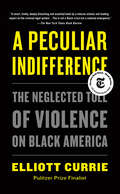
By Elliott Currie. 2020
A NEW YORK TIMES NOTABLE BOOK OF THE YEARFrom Pulitzer Prize finalist Elliott Currie comes a devastating exploration of the…
extreme levels of violence afflicting Black communities, and a blueprint for addressing the crisis About 170,000 Black Americans have died in homicides just since the year 2000. Violence takes more years of life from Black men than cancer, stroke, and diabetes combined; a young Black man in the United States has a fifteen times greater chance of dying from violence than his white counterpart. Even Black women suffer violent death at a higher rate than white men, despite homicide’s usual gender patterns. Yet while the country has been rightly outraged by the recent spate of police killings of Black Americans, the shocking amount of “everyday” violence that plagues African American communities receives far less attention, and has nearly disappeared as a target of public policy. As acclaimed criminologist Elliott Currie makes clear, this pervasive violence is a direct result of the continuing social and economic marginalization of many Black communities in America. Those conditions help perpetuate a level of preventable trauma and needless suffering that has no counterpart anywhere in the developed world. Compelling and accessible, drawing on a rich array of both classic and contemporary research, A Peculiar Indifference describes the dimensions and consequences of this enduring emergency, explains its causes, and offers an urgent plea for long-overdue social action to end it.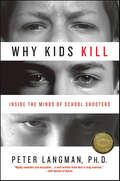
By Peter Langman. 2009
Ten years after the school massacre at Columbine High School in Colorado, school shootings are a new and alarming epidemic.…
While sociologists have attributed the trigger of violence to peer pressure, such as bullying and social isolation, prominent psychologist Peter Langman, argues here that psychological causes are responsible. Drawing on 20 years of clinical experience, Langman offers surprising reasons for why some teens become violent. Langman divides shooters into three categories, and he discusses the role of personality, trauma, and psychosis among school shooters. From examining the material evidence of notorious school shooters at Columbine and Virginia Tech to addressing the mental states of the violent youths he treats, Langman shows how to identify early signs of homicide-prone youth and what preventive measures educators, parents and communities can take to protect themselves from the tragedy.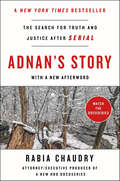
By Rabia Chaudry. 2016
After more than twenty years in prison, Adnan Syed’s murder conviction was overturned, and he was finally set free. Rabia…
Chaudry’s New York Times bestseller and award-winner Adnan’s Story reveals how the case was mishandled and became the subject of Sarah Koenig’s Peabody Award-winning podcast Serial.In early 2000, Adnan Syed was convicted and sentenced to life plus thirty years for the murder of his ex-girlfriend Hae Min Lee, a high school senior in Baltimore, Maryland. Syed has maintained his innocence, and Rabia Chaudry, a family friend, has always believed him. By 2013, after almost all appeals had been exhausted, Rabia contacted Sarah Koenig, a producer at This American Life, in hopes of finding a journalist who could shed light on Adnan’s story. In 2014, Koenig's investigation turned into Serial, a Peabody Award-winning podcast with more than 500 million international listeners.But Serial did not tell the whole story. In this compelling narrative, Rabia Chaudry presents key evidence that she maintains dismantles the State’s case: a potential new suspect, forensics indicating Hae was killed and kept somewhere for almost half a day, and documentation withheld by the State that destroys the cell phone evidence—among many other points—and she shows how fans of Serial joined a crowd-sourced investigation into a case riddled with errors and strange twists. Featuring information about Adnan’s life in prison, and weaving in his personal reflections with never-before-seen letters, Rabia’s account is “a true story about real people. Adnan’s Story adds context and humanizes it in a way that could change how you think about the case and about Serial itself” (Los Angeles Times).“Chaudry’s clear, vivid and highly readable account of the case will bring the story to life for readers unfamiliar with the podcast, and even the most devoted Serial fans will find fresh insight and a vast amount of new material. Chaudry’s legal training serves her well as she marshals her defense, but so too does the Pakistani heritage and Muslim faith she shares with Syed.” —Washington Post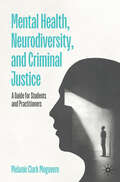
By Melanie Clark Mogavero. 2025
This book is a critical and thorough examination of the relationship between the criminal justice and mental health systems. The…
chapters cover a wide range of populations, focusing on those with neurodevelopmental disabilities, specifically autism and intellectual disability, mental illnesses such as post-traumatic stress disorder and schizophrenia, substance use disorders, and juveniles. This book covers the entire criminal justice process from initial contact, police questioning, the court system, community and custodial correctional systems, and the forensic mental health system. Specific topics addressed include community interactions and crisis intervention, comprehension of Miranda warnings, competency to stand trial, eyewitness identification procedures, admissibility of expert testimony, defenses of legal responsibility, community corrections, and ethical concerns with incarceration and eligibility for capital punishment. This book also covers the history and development of the criminal justice, juvenile justice, and mental health systems to contextualize modern-day policies and practices. With student-friendly features, current terminology, inclusive language, and key findings for criminal justice practitioners, this book serves as both a textbook and extensive reference for courses and for those seeking to learn more about these diverse populations and to have a positive impact. The content has international implications.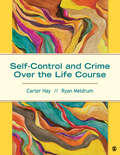
By Carter H. Hay, Ryan C. Meldrum. 2016
What exactly is self-control, and what life outcomes does it affect? What causes a person to have high or low…
self-control to begin with? What effect does self-control have on crime and other harmful behavior? Using a clear, conversational writing style, Self-Control and Crime Over the Life Course answers critical questions about self-control and its importance for understanding criminal behavior. Authors Carter Hay and Ryan Meldrum use intuitive examples to draw attention to the close connection between self-control and the behavioral choices people make, especially in reference to criminal, deviant, and harmful behaviors that often carry short-term benefits but long-term costs. The text builds an overall theoretical perspective that conveys the multi-disciplinary nature of modern-day self-control research. Moreover, far from emphasizing only theoretical issues, the authors place public policy at the forefront, using self-control research to inform policy efforts that reduce the societal costs of low self-control and the behaviors it enables.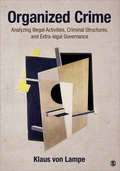
2016 Outstanding Publication Award (The International Association for the Study of Organized Crime) Organized Crime: Analyzing Illegal Activities, Criminal Structures,…
and Extra-legal Governance provides a systematic overview of the processes and structures commonly labeled "organized crime," drawing on the pertinent empirical and theoretical literature primarily from North America, Europe, and Australia. The main emphasis is placed on a comprehensive classificatory scheme that highlights underlying patterns and dynamics, rather than particular historical manifestations of organized crime. Esteemed author Klaus von Lampe strategically breaks the book down into three key dimensions: (1) illegal activities, (2) patterns of interpersonal relations that are directly or indirectly supporting these illegal activities, and (3) overarching illegal power structures that regulate and control these illegal activities and also extend their influence into the legal spheres of society. Within this framework, numerous case studies and topical issues from a variety of countries illustrate meaningful application of the conceptual and theoretical discussion.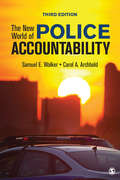
By Carol A. Archbold, Samuel E. Walker. 2020
"This book gives a brief yet thorough summary of the main components of police accountability in the 21st century. What…
works, what doesn’t, and where are we going in the future? I love to use it with my undergraduate students to help them understand the complexities of policing in the modern era." —Janne E. Gaub, East Carolina University Completely revised to cover recent events and research, the Third Edition of The New World of Police Accountability provides an original and comprehensive analysis of some of the most important developments in police accountability and reform strategies. With a keen and incisive perspective, esteemed authors and policing researchers, Samuel Walker and Carol Archbold, address the most recent developments and provide an analysis of what works, what reforms are promising, and what has proven unsuccessful. The book’s analysis draws on current research, as well as the President′s Task Force on 21st Century Policing and the reforms embodied in Justice Department consent decrees. New to the Third Edition: The national crisis over police legitimacy and use of force, is put into context through extensive discussions of recent police shootings and the response to this national crisis, providing readers a valuable perspective on the positive steps that have been taken and the limits of those steps. Coverage of the issues related to police officer uses of force is now the prevailing topic in Chapter 3 and includes detailed discussion of the topic, including de-escalation, tactical decision making, and the important changes in training related to these issues. An updated examination of the impact of technology on policing, including citizens’ use of recording devices, body-worn cameras, open data provided by police agencies, and use of social media, explores how technology contributes to police accountability in the United States. A complete, up-to-date discussion of citizen oversight of the police provides details on the work of selected oversight agencies, including the positive developments and their limitations, enabling readers to have an informed discussion of the subject. Detailed coverage of routine police activities that often generate public controversy now includes such topics as responding to mental health calls, domestic violence calls, and police "stop and frisk" practices. Issues related to policing and race relations are addressed head-on through a careful examination of the data, as well as the impact of recent reforms that have attempted to achieve professional, bias-free policing.
2016 Outstanding Publication Award (The International Association for the Study of Organized Crime) Organized Crime: Analyzing Illegal Activities, Criminal Structures,…
and Extra-legal Governance provides a systematic overview of the processes and structures commonly labeled "organized crime," drawing on the pertinent empirical and theoretical literature primarily from North America, Europe, and Australia. The main emphasis is placed on a comprehensive classificatory scheme that highlights underlying patterns and dynamics, rather than particular historical manifestations of organized crime. Esteemed author Klaus von Lampe strategically breaks the book down into three key dimensions: (1) illegal activities, (2) patterns of interpersonal relations that are directly or indirectly supporting these illegal activities, and (3) overarching illegal power structures that regulate and control these illegal activities and also extend their influence into the legal spheres of society. Within this framework, numerous case studies and topical issues from a variety of countries illustrate meaningful application of the conceptual and theoretical discussion.
By Carol A. Archbold, Samuel E. Walker. 2020
"This book gives a brief yet thorough summary of the main components of police accountability in the 21st century. What…
works, what doesn’t, and where are we going in the future? I love to use it with my undergraduate students to help them understand the complexities of policing in the modern era." —Janne E. Gaub, East Carolina University Completely revised to cover recent events and research, the Third Edition of The New World of Police Accountability provides an original and comprehensive analysis of some of the most important developments in police accountability and reform strategies. With a keen and incisive perspective, esteemed authors and policing researchers, Samuel Walker and Carol Archbold, address the most recent developments and provide an analysis of what works, what reforms are promising, and what has proven unsuccessful. The book’s analysis draws on current research, as well as the President′s Task Force on 21st Century Policing and the reforms embodied in Justice Department consent decrees. New to the Third Edition: The national crisis over police legitimacy and use of force, is put into context through extensive discussions of recent police shootings and the response to this national crisis, providing readers a valuable perspective on the positive steps that have been taken and the limits of those steps. Coverage of the issues related to police officer uses of force is now the prevailing topic in Chapter 3 and includes detailed discussion of the topic, including de-escalation, tactical decision making, and the important changes in training related to these issues. An updated examination of the impact of technology on policing, including citizens’ use of recording devices, body-worn cameras, open data provided by police agencies, and use of social media, explores how technology contributes to police accountability in the United States. A complete, up-to-date discussion of citizen oversight of the police provides details on the work of selected oversight agencies, including the positive developments and their limitations, enabling readers to have an informed discussion of the subject. Detailed coverage of routine police activities that often generate public controversy now includes such topics as responding to mental health calls, domestic violence calls, and police "stop and frisk" practices. Issues related to policing and race relations are addressed head-on through a careful examination of the data, as well as the impact of recent reforms that have attempted to achieve professional, bias-free policing.
By Carter H. Hay, Ryan C. Meldrum. 2016
What exactly is self-control, and what life outcomes does it affect? What causes a person to have high or low…
self-control to begin with? What effect does self-control have on crime and other harmful behavior? Using a clear, conversational writing style, Self-Control and Crime Over the Life Course answers critical questions about self-control and its importance for understanding criminal behavior. Authors Carter Hay and Ryan Meldrum use intuitive examples to draw attention to the close connection between self-control and the behavioral choices people make, especially in reference to criminal, deviant, and harmful behaviors that often carry short-term benefits but long-term costs. The text builds an overall theoretical perspective that conveys the multi-disciplinary nature of modern-day self-control research. Moreover, far from emphasizing only theoretical issues, the authors place public policy at the forefront, using self-control research to inform policy efforts that reduce the societal costs of low self-control and the behaviors it enables.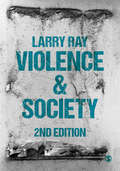
By Larry Ray. 2019
This highly respected title comes revised and updated in a second edition to provide you with a contemporary overview of…
violence and society. Clearly and lucidly written, this book offers broad coverage of theoretical debates, using case studies from the author’s own extensive research to bring the various theories alive. With a sociological approach throughout, it provides up-to-date coverage of key topics including gender and violence, collective violence and media and violence. New to this edition: Three new chapters on ‘Collective Violence’, ‘Violence and the Visual’ and ‘Theories of Violence′ Material on sex offending and the night-time economy Learning features in each chapter and an ‘at-a-glance’ overview within the introduction